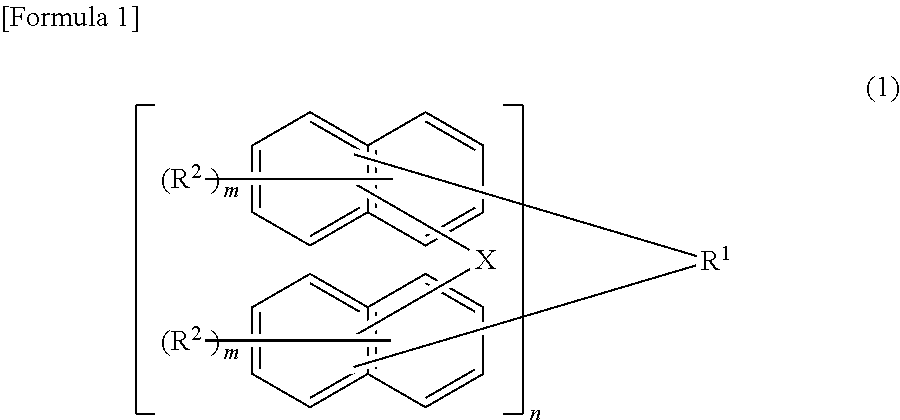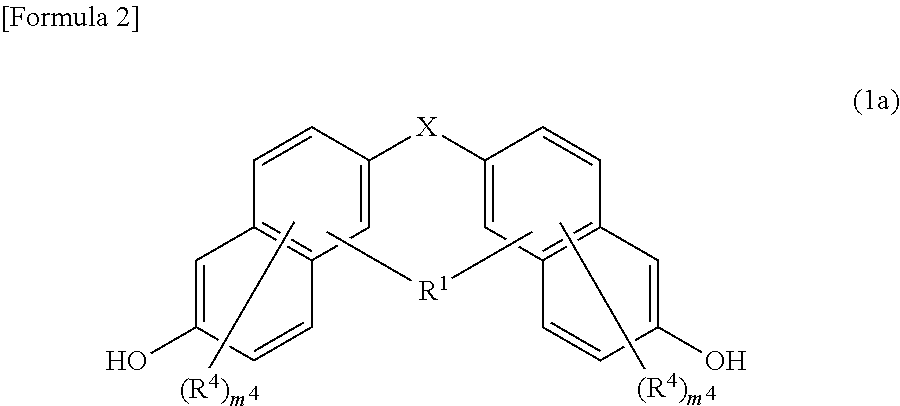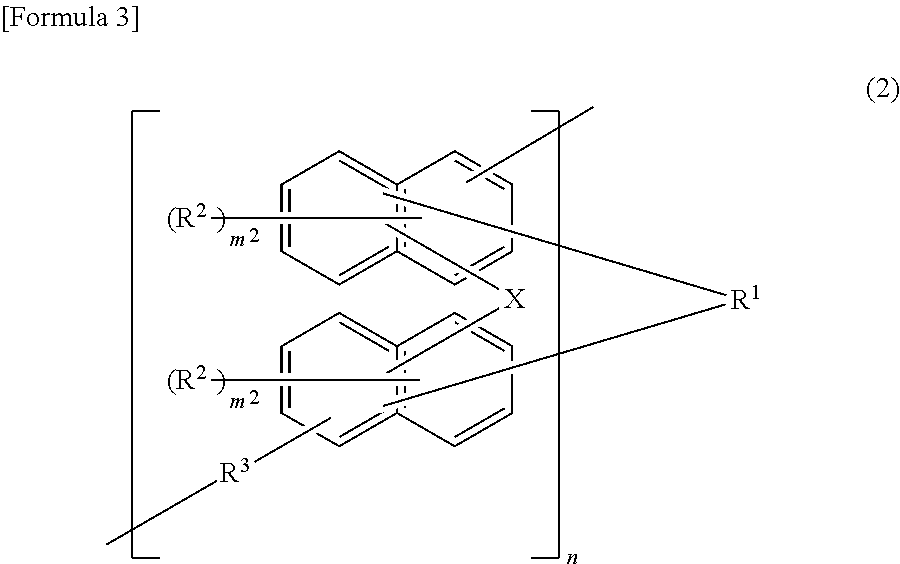Underlayer film-forming material for lithography, underlayer film for lithography, and pattern formation method
a technology of underlayer film and lithography, applied in the direction of photomechanical equipment, photosensitive material processing, instruments, etc., can solve the problems of high solvent solubility, achieve and achieve high carbon concentration, excellent heat resistance and etching resistan
- Summary
- Abstract
- Description
- Claims
- Application Information
AI Technical Summary
Benefits of technology
Problems solved by technology
Method used
Image
Examples
synthesis example 1
Synthesis of BisN-1
[0162]To a container having an inner volume of 100 ml, equipped with a stirrer, a condenser tube and a burette, were charged 1.60 g (10 mmol) of 2,6-naphthalenediol (reagent produced by Sigma-Aldrich Co., LLC.), 1.82 g (10 mmol) of 4-biphenylaldehyde (produced by Mitsubishi Gas Chemical Company, Inc.) and 30 ml of methyl isobutyl ketone, 5 ml of 95% sulfuric acid was added thereto, and a reaction liquid was stirred at 100° C. for 6 hours to perform a reaction. Then, the reaction liquid was concentrated, 50 g of pure water was added thereto to precipitate a reaction product, and the resultant was cooled to room temperature followed by filtration for separation. A solid obtained by filtration was dried, and separated and purified by column chromatography to thereby provide 3.05 g of an objective compound (BisN-1) represented by the following formula.
[0163]Herein, the following peaks were observed by 400 MHz-1H-NMR, and it was confirmed that the compound had a chemic...
synthesis example 2
Synthesis of BisN-2
[0171]Except that 3.20 g (20 mmol) of 2,7-naphthalenediol (reagent produced by Sigma-Aldrich Co., LLC.) was used instead of 3.20 g (20 mmol) of 2,6-naphthalenediol, the same manner as in Synthesis Example 1 was performed to thereby provide 0.2 g of an objective compound (BisN-2) represented by the following formula.
[0172]As a result of organic element analysis, the carbon concentration and the oxygen concentration of the resulting compound (BisN-2) were 84.5% and 10.3%, respectively. The carbon content rate is high and the oxygen content rate is low, and it is thus found that the etching resistance is high.
[0173]The molecular weight of the resulting compound was measured by the above method, and as a result, it was 464.
[0174]NMR measurement of the resulting compound was performed under the above measurement conditions, and the following peaks were observed. It was confirmed that the compound had a chemical structure of the following formula.
[0175]δ (ppm) 9.7 (2H, ...
synthesis example 3
Synthesis of BisN-3
[0179]Except that 3.20 g (20 mmol) of 1,5-naphthalenediol (reagent produced by Sigma-Aldrich Co., LLC.) was used instead of 3.20 g (20 mmol) of 2,6-naphthalenediol, the same manner as in Synthesis Example 1 was performed to thereby provide 0.2 g of an objective compound (BisN-3) represented by the following formula.
[0180]As a result of organic element analysis, the carbon concentration and the oxygen concentration of the resulting compound (BisN-3) were 84.5% and 10.3%, respectively. The carbon content rate is high and the oxygen content rate is low, and it is thus found that the etching resistance is high.
[0181]The molecular weight of the resulting compound was measured by the above method, and as a result, it was 464.
[0182]NMR measurement of the resulting compound was performed under the above measurement conditions, and the following peaks were observed. It was confirmed that the compound had a chemical structure of the following formula.
[0183]δ (ppm) 9.7 (2H, ...
PUM
| Property | Measurement | Unit |
|---|---|---|
| temperature | aaaaa | aaaaa |
| temperature | aaaaa | aaaaa |
| temperature | aaaaa | aaaaa |
Abstract
Description
Claims
Application Information
 Login to View More
Login to View More - R&D
- Intellectual Property
- Life Sciences
- Materials
- Tech Scout
- Unparalleled Data Quality
- Higher Quality Content
- 60% Fewer Hallucinations
Browse by: Latest US Patents, China's latest patents, Technical Efficacy Thesaurus, Application Domain, Technology Topic, Popular Technical Reports.
© 2025 PatSnap. All rights reserved.Legal|Privacy policy|Modern Slavery Act Transparency Statement|Sitemap|About US| Contact US: help@patsnap.com



